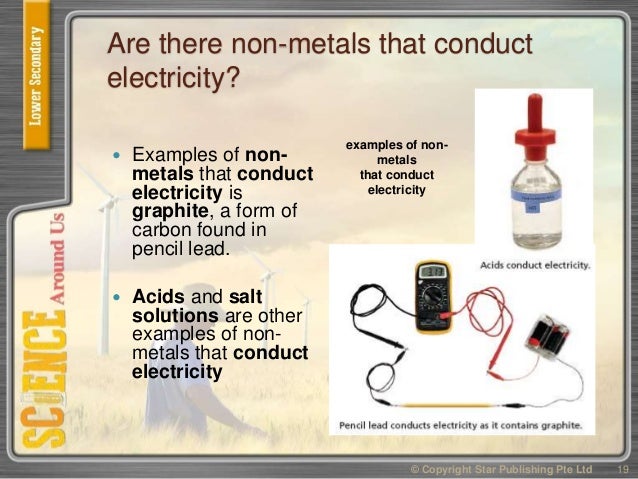do non metals conduct electricity
Hey there! Today, we're going to dive into the fascinating world of electricity and explore which materials conduct it. Get ready to be amazed by these mind-blowing discoveries!
Materials That Conduct Electricity
Electricity is a powerful force that plays a crucial role in our lives. It powers our homes, runs our devices, and fuels technological advancements. But have you ever wondered which materials allow electricity to flow through them? Let's find out!

First up, we have metals. Metals are excellent conductors of electricity due to their free-flowing electrons. The outermost electrons in metal atoms are not tightly bound to their nuclei, allowing them to move freely within the material. This flow of electrons forms an electric current, which is vital for electrical circuits to function.
But metals aren't the only materials that conduct electricity. Water, yes, good old H2O, also has the ability to conduct an electric current. You might think water is an insulator, but it becomes conductive when impurities or ions are dissolved in it. These impurities act as charge carriers, allowing electricity to pass through.

Another surprising conductor of electricity is the human body. Our bodies are made up of approximately 60% water, and as we learned earlier, water can conduct electricity. That's why it's crucial to handle electrical appliances with dry hands to avoid getting shocked.
Insulators: The Silent Guardians
While conductors allow electricity to flow freely, there's another group of materials that do just the opposite. Say hello to insulators. These remarkable materials work as protectors, minimizing the risk of electric shock and preventing energy loss in electrical systems.
One such insulator is rubber. Rubber is commonly used to coat electrical wires and cables. Its high resistance to electricity makes it an excellent choice for insulation. By keeping the electrical current within the wires, rubber ensures our safety and the efficient transmission of electricity.

Another common insulator is glass. Have you ever wondered why birds can safely sit on power lines without getting electrocuted? It's because the power lines are made of glass or ceramic, which are both excellent insulators. This insulation prevents electricity from flowing out of the lines and causing harm.
Now that we've explored the world of conductors and insulators, let's discuss how electricity travels through our homes and powers our appliances.
Electricity in Our Homes
When we flick a switch or plug in an appliance, we rely on a series of electrical circuits to provide power. Let's take a closer look at this incredible process!
First, electricity enters our homes through the main electrical panel, often located in the basement or garage. This panel distributes electricity to different areas of the house through individual circuit breakers or fuses.
Each circuit is responsible for supplying power to specific areas like the living room, kitchen, or bathroom. It's fascinating to think about the intricate network of wires running behind our walls, bringing electricity to every corner of our homes.

Now, let's focus on one of the most critical parts of any circuit – the switch. When we flip a switch, we are completing the electrical circuit and allowing the flow of electricity. This simple action turns on the lights, powers our devices, and brings life to our homes.
But how does electricity travel from the switch to our appliances? That's where outlets come into play. Electrical outlets are designed to provide a safe and convenient way to access electricity. They consist of two or three openings – the narrow slots and the round grounding pin.
When we plug our devices into the outlets, we create a connection between the appliance and the electrical circuit. Through this connection, electricity flows to our devices, making them come alive with power.
It's incredible to think about the journey of electricity from power plants to our homes and how it powers our everyday lives. Without electricity, our modern world would come to a standstill.
The Future of Electricity
As technology continues to advance, our reliance on electricity grows stronger. We are constantly searching for more efficient ways to generate, transmit, and utilize electricity in our everyday lives.
One of the most exciting developments in recent years is the rise of renewable energy sources. Solar power, wind energy, and hydroelectricity are just a few examples of clean and sustainable alternatives to fossil fuels.
Solar panels are becoming increasingly popular, allowing homeowners to harness the power of the sun and convert it into electricity. Not only does this reduce our dependence on non-renewable energy sources, but it also lowers our carbon footprint.
Similarly, wind turbines are being installed in various parts of the world to capture the power of the wind and generate electricity. This clean and inexhaustible source of energy holds immense potential for a greener future.
Lastly, hydropower harnesses the energy from flowing water, such as rivers and dams, to generate electricity. This renewable energy source is already widely used and provides a reliable and sustainable solution to our energy needs.

The future of electricity is bright, with advancements in technology paving the way for more efficient and eco-friendly energy solutions. As we strive for a sustainable world, it's crucial to embrace these innovations and make a positive impact on our planet.
So there you have it – a glimpse into the fascinating world of electricity and the materials that conduct it. From metals to water, from rubber to glass, and from power lines to renewable energy, electricity continues to shape our lives in countless ways.
Next time you turn on a light switch or charge your phone, take a moment to appreciate the incredible journey of electricity that powers your world.

